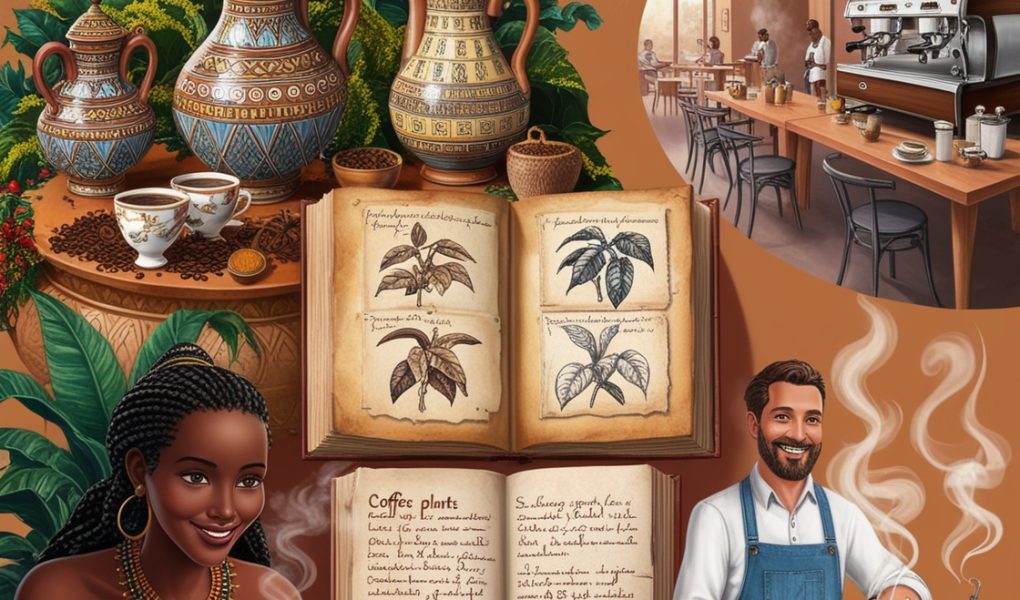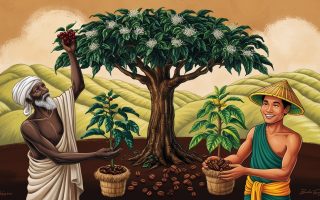Coffee has woven itself into the fabric of cultures around the globe, becoming a beloved beverage that fuels our mornings and sparks conversations. Its journey from the ancient hills of Ethiopia to the bustling modern cafés we know today is a rich tapestry of legend, exploration, and innovation. According to popular legend, coffee was discovered by a goat herder named Kaldi, who noticed his goats becoming more energetic after munching on the berries of the coffee plant. This discovery set off a chain reaction that would lead to the rise of coffee as a social staple in many societies.
From its humble beginnings in Ethiopia, coffee traveled to the Arabian Peninsula, where it found a warm welcome among Sufi monks. They used it to stay awake during long nights of prayer and meditation, leading to the establishment of the first coffeehouses, or qahveh khaneh, in the Middle East. These coffeehouses quickly became cultural hubs for intellectual exchange and social gatherings, influencing how coffee would be consumed in the centuries to come.
As coffee made its way to Europe in the 17th century, it transformed from a mystical elixir to a daily ritual, with coffeehouses emerging as gathering places for the Enlightenment’s greatest thinkers. This article will take you on a journey through the history of coffee, exploring its origins, its spread across the globe, and its evolution into the modern beverage we cherish today. Join us as we delve into the fascinating story of coffee—from its ancient roots to its contemporary status as a global phenomenon.
1. The Origins of Coffee
The story of coffee begins in the ancient highlands of Ethiopia, where the coffee plant, Coffea arabica, is believed to have originated. According to popular legend, it was a goat herder named Kaldi who first discovered the invigorating effects of coffee around the 9th century. Kaldi noticed that his goats became unusually energetic after consuming the bright red berries from a particular bush. Intrigued by their lively behavior, he sampled the berries himself and experienced a newfound sense of vitality. This serendipitous moment sparked the curiosity of local monks, who began using the berries to create a drink that kept them awake during long nights of prayer and meditation
As coffee’s popularity grew in Ethiopia, it transitioned from a simple fruit consumed for its stimulating properties to a revered beverage. By the 15th century, coffee cultivation had spread to the Arabian Peninsula, particularly Yemen, where it was cultivated and enjoyed as a drink in Sufi monasteries. The coffee trade began to flourish, and coffeehouses—known as qahveh khaneh—emerged as cultural centers for socializing and intellectual exchange
Ethiopia remains a significant player in the global coffee landscape, contributing to a rich cultural heritage. Today, over 15 million Ethiopians rely on coffee for their livelihoods, with the country being one of the world’s top producers. The unique terroir of Ethiopia, characterized by its high altitudes, volcanic soils, and diverse microclimates, produces coffee beans with a wide range of flavors and aromas, setting the stage for the complex and aromatic profiles that coffee lovers cherish.
2. The Spread of Coffee
As coffee began to make its mark on the world, its journey from the Ethiopian highlands to the Arabian Peninsula was both remarkable and transformative. After its initial discovery, coffee’s popularity surged in Yemen during the 15th century, where it was cultivated for the first time. This new beverage quickly gained traction among the local population, particularly among Sufi monks, who utilized its stimulating properties to stay alert during long hours of prayer and meditation
By the mid-15th century, coffeehouses, known as qahveh khaneh, started to emerge throughout the Arab world. These establishments quickly became vibrant social hubs, where people gathered to enjoy coffee while engaging in conversation, playing games, and discussing various topics from politics to poetry. The cultural significance of these coffeehouses cannot be overstated; they became spaces for intellectual exchange and community bonding. However, their popularity also attracted controversy, leading to periodic crackdowns by authorities concerned about the political discussions that took place within their walls
The spread of coffee wasn’t limited to the Arab world; it made its way to Europe in the 17th century. Venetian traders were among the first to introduce coffee to Europe, where it was initially regarded as a novelty. Soon, coffeehouses began popping up in major cities like London, Paris, and Vienna. In England, these establishments were dubbed “penny universities” because, for the price of a cup of coffee, one could gain access to lively debates and discussions
The Dutch played a significant role in expanding coffee cultivation, transporting coffee plants from Mocha, Yemen, to their colonies in the Caribbean and Indonesia. This laid the groundwork for coffee to become a global commodity, establishing vast plantations that would eventually dominate the coffee market
By the time coffee reached the Americas, it had already undergone significant transformations in flavor and preparation methods. The first coffee plants in the New World were brought to Brazil in the 18th century, and as coffee’s popularity soared, it became a cornerstone of the region’s economy
As we continue to explore the fascinating journey of coffee, it’s clear that its spread has shaped not only social and cultural norms but also economies and trade routes across the globe. The next section will delve into how coffee further influenced European society and its eventual establishment as a global phenomenon.
3. Coffee in Europe
The introduction of coffee to Europe marked a transformative moment in the continent’s social and cultural landscape. Coffee made its first appearance in Italy in the late 16th century, brought back by merchants who had traveled to the Middle East. Its exotic allure quickly captivated the wealthy elite in Venice, where the first coffeehouses began to emerge around 1645. These establishments quickly became popular gathering spots for intellectuals and artists, setting the stage for coffee’s role as a facilitator of discussion and debate
As coffee spread through Europe, it faced both curiosity and skepticism. Initially, some viewed it with suspicion, considering it a “bitter invention of Satan.” This perception changed when Pope Clement VIII tasted coffee and famously declared it delicious, effectively endorsing the beverage and helping to ease public apprehension.
The rise of coffeehouses in major cities such as London, Paris, and Vienna further solidified coffee’s status as a social beverage. In England, coffeehouses became known as “penny universities” because, for the price of a cup of coffee, patrons gained access to lively discussions on various topics, from politics to literature. This democratization of knowledge was significant, as it allowed people from different social classes to engage in dialogue and share ideas.
In France, coffee gained popularity through the efforts of influential figures such as Antoine Galland, who helped introduce it to the French court. By the 18th century, coffee was firmly established in French culture, with coffeehouses becoming hubs of enlightenment and creativity. The Viennese also embraced coffee, particularly after the Battle of Vienna in 1683, when they began serving it using supplies from the defeated Ottoman Turks. This led to the creation of unique coffee drinks, such as the famous Wiener Melange.
Throughout Europe, coffeehouses not only served as venues for socialization but also became centers for political thought and activism. The London Stock Exchange and other financial institutions trace their origins to these bustling cafés, where traders and thinkers exchanged ideas and laid the groundwork for modern economies
As coffee continued to weave itself into the fabric of European life, it became more than just a drink; it evolved into a cultural phenomenon that shaped social interactions and influenced various aspects of daily life. This chapter in coffee’s history is crucial as we explore its further evolution and impact on society, paving the way for the global coffee culture we know today.
4. The Coffee Trade and Colonialism
The journey of coffee from a regional curiosity to a global commodity is deeply intertwined with colonialism and the trade networks established by European powers. As coffee’s popularity surged in the 17th century, European nations sought to control its production, leading to the establishment of coffee plantations in their colonies. The Dutch were pioneers, planting coffee in Java, while the French cultivated it in the Caribbean, particularly in Haiti, which became a major supplier before the Haitian Revolution disrupted production.
In Brazil, coffee became the backbone of the economy, with vast plantations fueled by enslaved labor. By the 19th century, Brazil had become the world’s largest coffee producer, and coffee was deeply embedded in its social and economic structures . The reliance on slave labor raised ethical questions that continue to resonate today, as the impact of these historical practices still affects coffee-producing communities around the globe.
The global coffee trade transformed not only economies but also social dynamics. Coffeehouses emerged in colonial cities, acting as spaces for discussion and political activism. These venues were instrumental in fostering public discourse, influencing revolutions, and shaping modern political landscapes.
As we move forward in our exploration of coffee’s history, we’ll see how these early trade practices and colonial dynamics laid the groundwork for the contemporary coffee culture we enjoy today.
5. The Industrial Revolution and Coffee
The Industrial Revolution marked a turning point not only in manufacturing and urbanization but also in how coffee was consumed and appreciated. As factories sprang up across Europe in the late 18th century, coffee emerged as a vital source of energy for the workforce. Workers faced grueling hours in often harsh conditions, and coffee provided the stimulation needed to stay alert and focused.
During this era, coffeehouses—once venues for leisurely discussions—evolved into hubs of productivity. The atmosphere shifted as patrons, fueled by caffeine, engaged in intense conversations about business, politics, and ideas that would shape the future. This transformation led to the emergence of concepts like the London Stock Exchange, which can trace its roots back to discussions held in coffeehouses. These establishments became known as “penny universities,” where for the cost of a cup, one could access a wealth of information and social interaction.
The Industrial Revolution also revolutionized coffee processing and preparation. Technological advancements allowed for the mass production of coffee, making it more accessible to the working class. Coffee machines, steam-powered roasters, and automated grinding techniques streamlined the brewing process. This era saw coffee transition from a luxury item to a daily staple for many, helping workers maintain productivity without the heavy effects of alcohol, which had previously been their drink of choice.
Moreover, the increasing demand for coffee spurred international trade and shipping innovations. As coffee plantations expanded in colonies across the globe, the need for efficient transportation networks grew. Ships were redesigned to carry the growing volumes of coffee beans, establishing crucial trade routes that continue to underpin the global coffee market today.
In summary, coffee not only fueled the industrious spirit of the Industrial Revolution but also adapted to the changing needs of society. As we move forward in our exploration of coffee’s history, we’ll see how these developments laid the groundwork for the vibrant coffee culture that thrives in modern cafés around the world.
6. The Modern Coffee Movement
As we entered the 21st century, coffee culture underwent a profound transformation, giving rise to what is now known as the modern coffee movement. This evolution has been driven by an increasing awareness of quality, sustainability, and the intricate craftsmanship behind each cup.
At the forefront of this movement is the third-wave coffee philosophy, which emerged as a reaction to the commodification of coffee. Instead of viewing coffee as merely a beverage, this movement treats it as an artisanal product, focusing on its origins, processing methods, and unique flavor profiles. Coffee enthusiasts began to seek out single-origin beans, allowing for a deeper appreciation of the specific regions and farmers who cultivate them.
The rise of specialty cafés is another hallmark of the modern coffee movement. These establishments prioritize quality over quantity, offering meticulously brewed cups using various methods such as pour-over, siphon, and cold brew. They serve as community spaces where patrons can gather to enjoy not just coffee, but an experience. Many of these cafés host cupping sessions, workshops, and other events, fostering a sense of community and a shared love for coffee.
Sustainability has also taken center stage in this new coffee era. Consumers are increasingly conscious of the impact of their choices, prompting coffee brands to adopt ethical sourcing practices. Fair trade and organic certifications have become important criteria for many coffee drinkers, as they seek to ensure that farmers receive fair compensation and that environmentally friendly practices are employed.
Technology has played a significant role in reshaping coffee culture as well. From smart coffee machines to apps that help track coffee consumption, the way we brew and enjoy coffee has become more connected and innovative. Social media platforms have facilitated the sharing of coffee knowledge, enabling communities of enthusiasts to form and grow.
In conclusion, the modern coffee movement reflects a dynamic and evolving relationship with this beloved beverage. It emphasizes quality, sustainability, and community, inviting coffee lovers to explore the rich tapestry of flavors and stories behind every cup. As we continue to enjoy our daily brew, we participate in a tradition that honors the artistry and culture surrounding coffee, connecting us to its ancient roots while embracing the innovations of today.
Final Thoughts
The history of coffee is a rich and fascinating journey that spans centuries and continents, from its humble beginnings in the highlands of Ethiopia to its establishment as a global cultural phenomenon. Coffee has transformed from an ancient beverage, revered for its stimulating properties, to a complex drink enjoyed in various forms around the world. Each phase of its journey has contributed to the diverse coffee culture we celebrate today, underscoring its importance in social interactions and community building.
Throughout its evolution, coffee has not only fostered connections among people but also reflected the economic and political landscapes of its time. From the lively coffeehouses of the Middle East that sparked intellectual debates to the European salons that nurtured revolutionary ideas, coffee has always been at the heart of cultural exchange. Moreover, the modern coffee movement highlights a renewed focus on sustainability, quality, and the stories behind each cup, connecting us back to the coffee farmers and regions that produce our favorite brew.
As we savor our daily coffee, we partake in a tradition that bridges ancient history with contemporary practices. The legacy of coffee continues to thrive, reminding us of its role as a catalyst for conversation, creativity, and community. Whether enjoyed in a cozy café or brewed at home, each cup carries with it the weight of history, a story waiting to be shared and appreciated.
For those interested in diving deeper into the intricacies of coffee’s past, numerous resources and articles offer a wealth of information. Engaging with coffee’s rich heritage not only enhances our appreciation for this beloved beverage but also strengthens our connection to the global community that sustains it.



